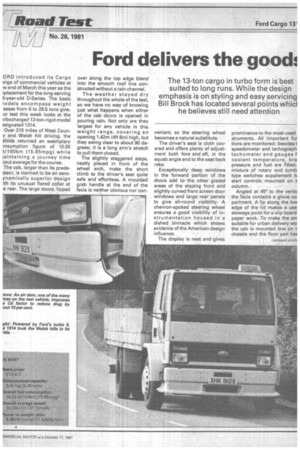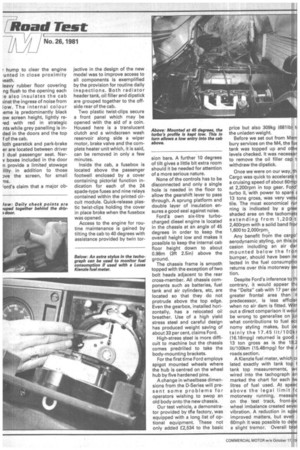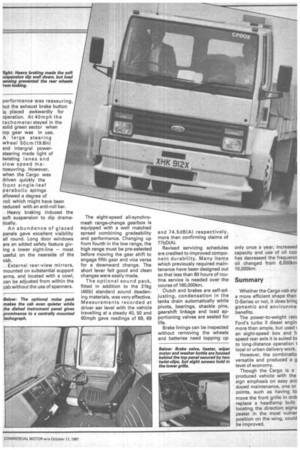Ford delivers the good
Page 31

Page 32

Page 33

If you've noticed an error in this article please click here to report it so we can fix it.
The 13-ton cargo in turbo form is best suited to long runs. While the design emphasis is on styling and easy servicing Bill Brock has located several points whicl he believes still need attention
ORD introduced its Cargo )nge of commercial vehicles at le end of March this year as the )placement for the long-serving 6-year-old D-Series. The basic lodels encompass weight asses from 6 to 28.5 tons gvw. ur test this week looks at the irbocharged 13-ton-rigid model esignated 1314.
Over 210 miles of West Couny and Welsh hill driving, the 3hicle returned an exemplary )nsumption figure of 10.05 t/100km (15.65mpg) while iaintaining a journey time )out average for the course. The cab, larger than its prede?ssor, is claimed to be an aeroynamically superior design ith its unusual flared collar at le rear. The large doors, lipped
over along the top edge blend into the smooth roof line constructed without a rain channel.
The weather stayed dry throughout the whole of the test, so we have no way of knowing just what happens when either of the cab doors is opened in pouring rain. Not only are they largest for any vehicle in this weight range, covering an opening 1.42m (4ft 8in) high, but they swing clear to about 90 degrees; it is a long arm's stretch to pull them closed.
The slightly staggered steps, neatly placed in front of the wheel arch, make the short climb to the driver's seat quite safe and effortless. A moulded grab handle at the end of the facia is neither obvious nor con
venient, so the steering wheel becomes a natural substitute.
The driver's seat is cloth covered and offers plenty of adjustment both fore and aft, in the squab angle and to the seat back rake.
Exceptionally deep windows in the forward portion of the doors add to the other glazed areas of the sloping front and slightly curved front screen door windows and large rear panels to give all-round visibility. A chevron-spoked steering wheel ensures a good visibility of instrumentation housed in a dished binnacle which shows evidence of the American design influence.
The display is neat and gives prominence to the most used struments. All important fur tions are monitored; besides t speedometer and tachograph tachometer and gauges f coolant temperature, bra pressure and fuel are fitted. mixture of rotary and tumb type switches supplement start controls mounted on t column.
Angled at 450 to the vertic the facia contains a glove col partment. A lip along the lovi edge of the lid makes a use stowage point for a clip board paper work. To make the eni suitable for urban delivery wo the cab is mounted low on t chassis and the floor pan haf.
hump to clear the engine unted in close proximity ieath.
leavy rubber floor covering ng flush to the opening each e also insulates the cab linst the ingress of noise from low. The internal colour eme is predominantly black ow screen height, lightly refed with red in strategic nts while grey panelling is inded in the doors and the top f of the cab.
loth gearstick and park-brake er are located between driver I dual passenger seat. Narv boxes included in the door n provide a limited stowage ility in addition to those Dve the screen, for small T1S.
'ord's claim that a major ob jective in the design of the new model was to improve access to all components is exemplified by the provision for routine daily inspections. Both radiator header tank, oil filler and dipstick are grouped together to the offside rear of the cab.
Two plastic twist-clips secure a front panel which may be opened with the aid of a coin. Housed here is a translucent clutch and a windscreen wash reservoir along side a wiper motor, brake valve and the complete heater unit which, it is said, can be removed in only a few minutes.
Inside the cab, a fusebox is located above the passenger footwell enclosed by a cover containing pictorial function indication for each of the 24 spade-type fuses and nine relays contained within the printed circuit module. Quick-release plastic twist-clips holding the cover in place broke when the fusebox was opened.
Access to the engine for routine maintenance is gained by tilting the cab to 40 degrees with assistance provided by twin tor sion bars. A further 10 degrees of tilt gives a little bit extra room should it be needed for attention of a more serious nature.
None of the controls has to be disconnected and only a single hole is needed in the floor to allow the gearshift lever to pass through. A sprung platform and double layer of insulation ensures a good seal against noise.
Ford's own six-litre turbocharged diesel engine is located in the chassis at an angle of 45 degrees in order to keep the overall height low and makes it possible to keep the internal cab floor height down to about 0.98m (3ft 2.5in) above the ground.
The chassis frame is smooth topped with the exception of two bolt heads adjacent to the rear cross-member. All chassis components such as batteries, fuel tank and air cylinders, etc, are located so that they do not protrude above the top edge. Even the gearbox, installed horizontally, has a relocated oil breather. Use of a high yield stress steel and careful design has produced weight saving of about 33 per cent, claims Ford.
High-stress steel is more difficult to machine but the chassis comes predrilled to take the body-mounting brackets.
For the first time Ford employs spigot mounted wheels where the hub is centred on the wheel hub by five hardened pins.
A change in wheelbase dimensions from the D-Series will present some problems for operators wishing to swop an old body onto the new chassis.
Our test vehicle, a demonstrator provided by die factory, was equipped with a long list of optional equipment. These not only added £2,534 to the basic price but also 309kg (6811b) ti the unladen weight.
Before we set out from Mem bury services on the M4, the fuE tank was topped up and othe levels checked. It was necessar to remove the oil filler cap t, withdraw the dipstick.
Once we were on our way, th Cargo was quick to accelerate t, a cruising speed of about 60mp at 2,200rpm in top gear. Ford' turbo II, with power to spare e 13 tons gross, was very verse tile. The most economical rur ning is indicated by a gree shaded area on the tachometE extending from 1,2 0 0 t 2,400rpm with a solid band fror 1,600 to 2,000 rpm..
Any benefit from the cargo' aerodynamic styling, on this oc casion including an air dar mounted below the fron bumper, should have been re. lected in the fuel consumptio returns over this motorway sec tion.
Despite Ford's inference to th contrary, it would appear the the "Delta" cab with 17 per cer greater frontal area than it predecessor, is less efficier when no air dam is fitted. Witl' out a direct comparison it woul be wrong to generalise on jut what contributions to fuel ect nomy styling makes, but ce tainly the 1 7.4 5 lit/1 0 Okr (16.18mpg) returned is good e 13 ton gross as is the 18.2 lit/100km (15.48mpg) for the roads section.
A Kienzle fuel meter, which cc lated exactly with tank top t tank top measurements, We wired into the tachograph an marked the chart for each tw litres of fuel used. At speec above the legal limit fc motorway running, measure on the test track, front-ex wheel imbalance created sevei vibration. A reduction in speE improved matters, but even 60mph it was possible to dote a slight tremor. Overall bral performance was reassuring, but the exhaust brake button is placed awkwardly for operation. At 40mph the tachometerstayed in the solid green sector when top gear was in use. A large steering wheel 50crn (19.8in) and intergral powersteering made light of twisting lanes and Blow speed manoeuvring. However, when the Cargo was driven quickly the front single-leaf parabolic springs allowed a degree of roll which might have been reduced with an anti-roll bar.
Heavy braking induced the soft suspension to dip dramatically.
An abundance of glazed panels gave excellent visibility all round. Long door windows are an added safety feature giving a lower sight-line — most useful on the nearside of the cab.
External rear-view mirrors, mounted on substantial support arms, and located with a cowl, can be adjusted from within the cab without the use of spanners. The eight-speed all-synchromesh range-change gearbox is equipped with a well matched spread combining gradeability and performance. Changing up from fourth in the low range, the high range must be pre-selected before moving the gear shift to engage fifth gear and vice versa for a downward change. The short lever felt good and clean changes were easily made.
The optional sound pack, fitted in addition to the 21kg (461b) standard sound deadening materials, was very effective. Measurements recorded at driver ear level with the vehicle travelling at a steady 40, 50 and 60mph gave readings of 69, 69 and 74.5dB(A) respectively, more than confirming claims of 77bD(A).
Revised servicing schedules are credited to improved component durability. Many items which previously required maintenance have been designed out so that less than 80 hours of routine service is needed over the course of 160,000km.
• Clutch and brakes are self-adjusting, condensation in the tanks drain automatically while pivots, bearings, shackle pins, gearshift linkage and load apportioning valves are sealed for life.
Brake linings can be inspected without removing the wheels and batteries need topping up only once a year. Increased capacity and use of oil coo has decreased the frequenc) oil changed from 6,500km 10,000km.
Summary
Whether the Cargo cab styl a more efficient shape than D-Series or not, it does bring gonomic and environmel benefits.
The power-to-weight ratic Ford's turbo II diesel engin more than ample, but used an eight-speed box and h speed rear axle it is suited bE to long-distance operation t local or urban delivery work.
However, the combinatio versatile and produced a g level of economy.
Though the Cargo is a produced vehicle with the sign emphasis on easy anc duced maintenance, one or points, such as having to move the front grille in orcIE replace a headlamp bulb locating the direction signa peater in the most vulner position on the wing, could be improved.








































